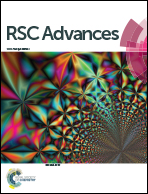Depolarization effects of Li2FeSiO4 nanocrystals wrapped in different conductive carbon networks as cathodes for high performance lithium-ion batteries†
Abstract
We report composite electrodes with Li2FeSiO4 (LFS) nanocrystals wrapped in three different types of conductive carbon such as Acetylene Black (AB), carbon nanotubes (CNT) and Ketjen Black (KB) to demonstrate depolarization effects on the electrochemical performance of Li-ions batteries. KB with a nanoporous structure and the largest surface area enabled the formation of the best electronic conductive-network with excellent capacity on the interface of LFS nanoparticles, showing reversible electrochemical activity. Compared to the electrodes of LFS wrapped in AB and CNT, the polarization of LFS particles wrapped in KB was reduced significantly due to high conductivity of the electrode, resulting in an increase of about 59.0% in the reversible capacity (269.0 mA h g−1, corresponding to 1.62 Li-storages) and obvious enhancement in the rate performance. By using the electrochemical analysis methods, we demonstrated the insight of discharge of more than one lithium ion at different voltages in the LFS@KB vs. LFS@AB and LFS@CNT electrodes, including interface capacity, Fe3+/Fe2+ and Fe4+/Fe3+ redox, respectively. The fundamental mechanism of enhanced electrochemical performance of LFS by creating a depolarization environment with optimized conductive carbon provides useful guidance to the future design of high performance LFS cathodes for LIBs.


 Please wait while we load your content...
Please wait while we load your content...